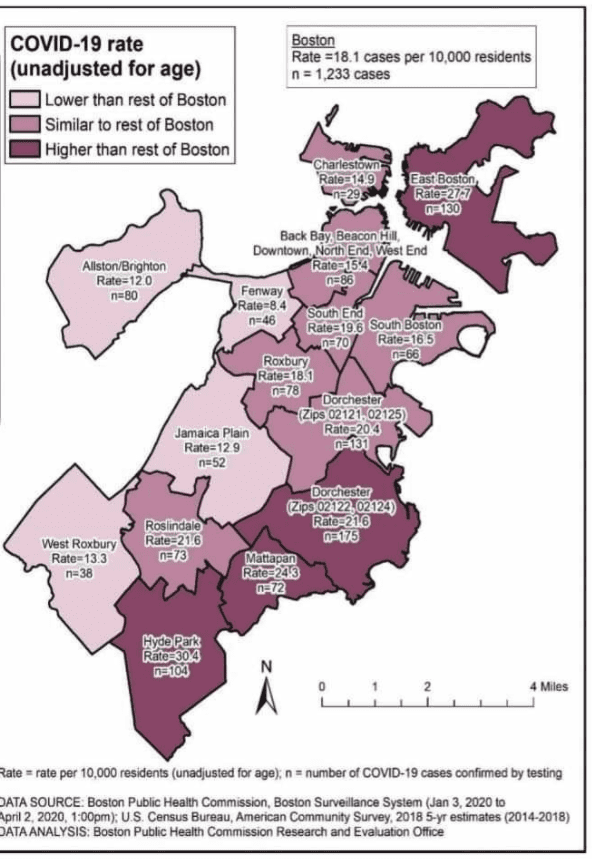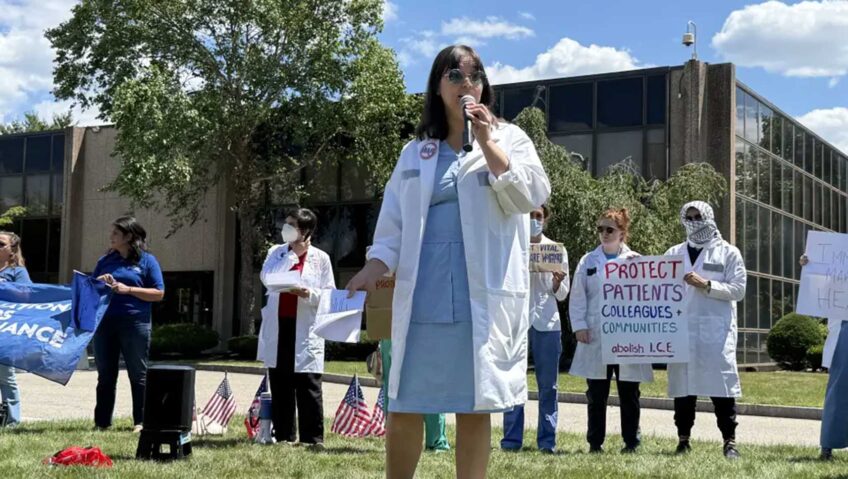
Yawu Miller
Data from the Boston Public Health Commission suggests that blacks in the city are being infected with the coronavirus at a rate nearly twice their percentage of the population.
The BPHC data show blacks as 42 percent of those infected where race was identified. Blacks make up 22 percent of the city’s population. While the data is incomplete, the suggestion of high rates of infection among blacks is backed up by BPHC neighborhood data showing the highest concentrations of infection in Hyde Park, Mattapan and Dorchester.
The BPHC data, first released on Thursday and updated daily, also demonstrates the difficulty local and state authorities are encountering amassing reliable data. As of Sunday, race was identified in just 62% of the 3,916 cases recorded in Boston. Latinos, who account for 20 percent of the city’s population, were identified in 16 percent of the cases, despite a recorded infection rate in majority-Latino East Boston that is the second-highest in the city.
Infection rates among Latinos may be under-reported, as many health providers lack adequate translation services.
In response to the apparent disproportionate infection rates, Mayor Martin Walsh has assembled a new COVID-19 Health Inequities Task Force to help the city better serve black, Latino and Asian communities.
“We know that there are significant inequities that put our communities of color and immigrant population at higher risk for contracting coronavirus, developing severe illness and impeding them from accessing care,” Walsh said.
The data city officials provided includes whites, blacks, Latinos and Asians, but has not been disaggregated to show nationalities such as Vietnamese, Cape Verdeans or Central Americans. Immigration status is also not recorded in the data. Asians, who account for 9% of the city’s population, accounted for just 4% of infections in the city’s data.
Of patients where race is reported, 57% of COVID-19 positive patients are either black or Hispanic/Latino, according to the BPHC data released Friday. Additionally, 61% of COVID-19 positive patients are from Dorchester, Roxbury, Hyde Park and Mattapan. Many of BMC’s COVID-19 positive patients have presented with higher rates of underlying conditions compared to historical data, including 34% with diabetes, 49% with hypertension and 52% with a Body Mass Index above 30, indicating obesity.
The BPHC data defines neighborhoods by zip codes, which don’t neatly correspond to popular notions of neighborhood boundaries.
As of Sunday, the South End, Chinatown and Lower Roxbury zip codes 02111 and 02118 show the highest rate of infection, according to the BPHC data, with 78.9 percent of infections per 10,000 residents — more than twice the rate in the more heavily-white neighborhoods of West Roxbury (34.1 per 10,000) and Back Bay/Beacon Hill (23.2 per 10,000). The South End’s numbers include 240 people experiencing homelessness who list shelters in the South End as a home address. A third of the city’s homeless population has tested positive for the virus.
East Boston’s rate of infection, 50.7 per 10,000, underscores the risks facing low-wage workers in that majority Latino neighborhood. When the MBTA first cut service to subway lines two weeks ago, essential workers in East Boston commuting to grocery stores, hospitals and janitorial services jobs were crowded on Blue Line trains heading toward downtown Boston.
While the MBTA has since restored rush hour service to the Blue Line as well as to the Green Line branches accessing the Longwood Medical area, many workers face continued exposure as they ride public transit to access essential jobs.
State Rep. Liz Miranda, who represents the 5th Suffolk District in Dorchester and Roxbury, made an appeal to her constituents to observe social distancing norms and stay home.
“The cases that are happening in my district now are almost all young black men and Latino men,” she said. She noted that she has seen people playing soccer and basketball in parks in her district. “You cannot be throwing parties,” she added. “You cannot be going to basements for card games.”
Members of the city’s new COVID-19 Health Inequities Task Force include:
- Dr. Thea James, Boston Medical Center
- Vanessa Calderón-Rosado, IBA
- Manny Lopes, East Boston Health Center
- Guale Valdez, Mattapan Community Health Center
- Carol Rose, ACLU
- Alexandra Oliver-Dávila, Sociedad Latina
- Frederica Williams, Whittier Street Health Center
- Michael Curry, Mass League of Community Health Centers
- Dr. Joseph Betancourt, MGH
- Karen Chen, CPA
- Tanisha Sullivan, NAACP
- Michele Courton Brown, Quality Interactions
- Rev. Ray Hammond, Bethel AME Church
- Rev. Gloria White Hammond, Bethel AME Church
- Paul Watanabe, UMass Boston
- Dr. Lorna Rivera, UMass Boston
- Suzanne Lee, former principal, Josiah Quincy School
- Eva Millona, MIRA Coalition
- Marie St. Fleur, St. Fleur Communications, former State Representative
- Rev. Sam Acevedo, COPHANI
- Petrina Cherry, Boston Medical Center
- Linda Dorcena Forry, Suffolk Construction
- Dr. Jean Alves, Bowdoin Street Health Center
- Dr. Myechia Minter-Jordan, DentaQuest Partnership for Oral Health Advancement
According to the Mayor’s Office, the Task Force will review existing racial and ethnic data among Boston residents, as well as review data collection processes, data analysis and best practices related to the COVID-19 response for the Black, Latino, Asian and immigrant populations.
Material from the Mayor’s Press Office has been included in this report.







